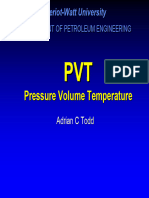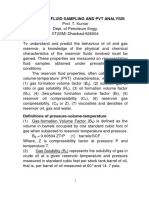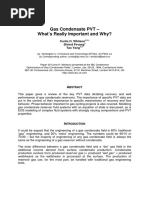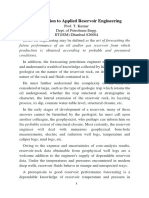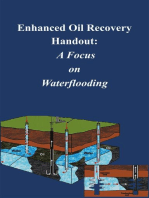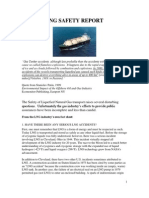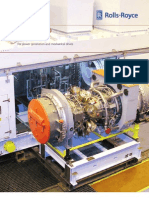Swtsec10 Terms
Swtsec10 Terms
Uploaded by
Amith MenonCopyright:
Available Formats
Swtsec10 Terms
Swtsec10 Terms
Uploaded by
Amith MenonOriginal Description:
Copyright
Available Formats
Share this document
Did you find this document useful?
Is this content inappropriate?
Copyright:
Available Formats
Swtsec10 Terms
Swtsec10 Terms
Uploaded by
Amith MenonCopyright:
Available Formats
10 1 Surface Well Testing
Section 10
Exploration and Production
Terms
Table of Contents
Introduction .............................................................................................................................................. 10-3
Objectives ................................................................................................................................................ 10-3
Terminology ............................................................................................................................................. 10-4
Comment [GA1]:
10 3 Surface Well Testing
Introduction
The section will
Objectives
After completing this section, you should be able to
Exploration and Production Terms
10 4 Surface Well Testing
Terminology
Bubble point of a reservoir system is the state characterized by the coexistence of a
substantial amount of liquid phase and an infinitesimal amount of gas phase in
equilibrium.
Compressibility factor (gas-deviation factor, supercompressiblity factor) is a multiplying
factor introduced into the ideal gas law to account for the departure of true gases from
ideal behavior (pV = nzRT; z is the compressibility factor).
Condensate (distillate) liquids are liquids formed by condensation of a vapor or gas.
The term usually identifies a light-colored liquid, usually of 50 degrees API gravity or
higher, obtained from systems that exist in the gaseous phase in the reservoir.
Critical state is the term used to identify the unique condition of pressure, temperature,
and composition wherein all properties of coexisting vapor and liquid become identical.
Critical temperature Tc and/or critical pressure Pc is the temperature or pressure at the
critical state.
Dew point of a system is analogous to the bubble point in that a large volume of gas and
an infinitesimal amount of liquid coexist in equilibrium.
Dissolved gas (solution gas) identifies material which ordinarily is gaseous at
atmospheric conditions but which is part of a liquid phase at elevated pressure and
temperature.
Flash process is one in which the composition of the system remains constant but the
proportion of gas and liquid phases that comprise the system changes as pressure or some
other independent variable is changed. For example, the determinations of the PV
relations of a reservoir fluid sample involves a flash process.
Formation volume factor is a means of expressing a volumetric relation of a system at
formation pressure and temperature, that results in one surface barrel of oil (Bo) or water
(Bw) at standard conditions. Gas formation volume (Bg) refers to the volume in the
reservoir (usually expressed as barrels per 1,000 surface standard cubic feet of the gas).
Exploration and Production Terms
10 5 Surface Well Testing
Gas gravity is a simple means of expressing the molecular weight of a gas. The
standard of gas gravity is dry air of molecular weight 28.97. Thus, methane (molecular
weight = 16.04) has a gas gravity of 16.04/28.97 = 0.55.
Gas-oil ratio is a loose expression of system composition. Normally, the units involved
are cubic feet of gas per one barrel of liquid, both measured at 14.7 psia and 60 F.
Pressure and temperature of separation and the number of stages used affect the gas-oil
ratio number obtained for a given system.
Pseudocritical and Pseudoreduced Properties (Temperature, Pressure). Properties of
pure hydrocarbons are often the same when expressed in terms of their reduced
properties. The same reduced-state relationships often apply to multi-component
systems if 'pseudo' critical temperatures and pressures are used rather than the true
critical of the systems. Calculation of the pseudocritical values from the composition of
the system varies depending on the correlation being used. The ration of pseudoreduced
pressure Ppr = P/Ppc.
Reduced properties (temperature, pressure, volume) are the ratio of the property to the
critical property; for example, the reduced pressure Pr = P/Pc.
Saturated liquid (vapor) is a liquid which is in equilibrium with vapor at the saturation
pressure. Likewise, saturated vapor denotes equilibrium with liquid. These terms are
often used synonymously with the term bubble-point liquid (dew-point vapor) at the
bubble-point (dew-point) pressure. It should be noted that the terms 'bubble-point' and
'dew-point' identify the special case where the minor phase is present only in an
infinitesimal amount whereas the term 'saturated liquid' does not involve the relative
amounts of phases present.
Shrinkage refers to the decrease in volume of a liquid phase caused by release of solution
gas and/or by the thermal contraction of the liquid. Shrinkage may be expressed (1) as a
percentage of the final resulting stock-tank oil or (2) as a percentage of the original
volume of the liquid. Shrinkage factor is the reciprocal of formation volume factor
expressed as barrels of stock-tank oil per barrel of reservoir oil. A reservoir oil that
resulted in 0.75 bbl of stock-tank oil per 1 bbl of reservoir oil would have a shrinkage of
0.25/0.75 = 33 per cent under definition (1), a shrinkage of 0/25/1.00 = 25 per cent under
definition (2), a shrinkage factor of 0.75, and a formation volume factor of 1.00/0.75 =
1.33.
Standard conditions (surface) are 14.7 psia and 60 F. Gas volumes may be specified upon
occasion at pressures slightly removed from 14.7 psia.
Stock-tank oil is the liquid that results from production of reservoir material through
surface equipment that separates normally gaseous components. Stock-tank oil may be
Exploration and Production Terms
10 6 Surface Well Testing
caused to vary in composition and properties by varying the conditions of gas-liquid
separation. Stock-tank oil is normally reported at 60 F and 14.7 psia but may be
measured under other conditions and corrected to the standard condition.
System refers to a body or to a composition of matter that represents the material under
consideration. The term "system" may be defined further as a homogenous system. In
a homogenous system, the intensive properties vary only in a continuous manner with
respect to the extent of the system. A heterogeneous system is made up of a number of
homogenous parts, and abrupt changes in the intensive properties occur at the interface
between the homogenous parts.
Undersaturated fluid (liquid or vapor) is material capable of holding additional gaseous
or liquid components in solution at the specified state.
Familiarization of Terminology
Some common terms are briefly defined below in order to give an understanding of their
general meaning only, and do not always accurately encompass the fully technical scope
of the term.
Production testing - A general procedure of flowing a well under controlled conditions in
order to obtain basic information from which the well's performance can be observed or
calculated. The well's deliverability, productivity, AOF potential, etc., as well as the
amounts and composition of the wellstream effluent are derived or calculated from the
test results.
Pressure drawdown - The difference between shut in pressure and flowing pressure at a
given rate. Drawdown is usually expressed as a per cent of the initial shut in pressure.
In this case, it is calculated by subtracting the flowing pressure from the shut in pressure
and dividing the difference (drawdown) by the shut in pressure. The quotient is then
multiplied by 100 to obtain the per cent of drawdown.
Example: Initial shut in pressure 1850 psig
Flowing pressure -1450 psig
400 psig
Per cent of drawdown 400 x 100 = 21.6%
1850
Exploration and Production Terms
10 7 Surface Well Testing
Deliverability - The well's productivity with reference to the conditions at the wellhead,
rather than at the formation's sand face. The important elements of a well's
deliverability are rates against several levels of pipeline suction pressures, liquid lifting
ability, flowing wellhead temperatures and possible hydrating conditions.
Sandface - Refers to the vertical wall of the production interval. It can be the casing
wells within the perforated interval or, in an open hole completion, it is the drilled
producing formation rock wall.
Reservoir - The porous and permeable rock formation containing and capable of flowing
fluids such as natural gas, crude oil or water. As considered from a single well, it is a
region of the reservoir surrounding the well in a radial fashion.
Reservoir limits - Discontinuities or ends of the reservoir which limit its extent.
Saturation - The portion of the pore space occupied by either gas, oil or condensate and
water and is usually expressed in a per cent of each of these elements. The total
saturation of all these elements is always 100 per cent. The gas phase may flow at very
low saturation levels, but the reservoir liquids sometimes need as much as or more than
40 per cent saturation in order to become a mobile phase flow toward the wellbore.
Porosity - The average fraction of reservoir volume or space not occupied by reservoir
rock, but which is filled by reservoir fluids or gas. Porosity is usually expressed in per
cent. The reservoir pore spaces may be more or less connected to each other.
Permeability - The degree of interconnection of the pore spaces which permits the
reservoir fluids to move from one space to another. Permeability is an index of flow
capacity for each element of the pay zone. Its unit is the darcy or milidarcy (md.)
Flow capacity - The total ability of the whole reservoir section penetrated by a well to
produce reservoir fluids. Its unit is the darcy foot or the milidarcy foot ( md-ft).
AOF potential - A standardized method to express the theoretical flow capacity of a gas
well so that it can be readily compared to other wells. The abbreviation stands for
absolute open flow potential. The AOF value is obtained by extrapolation of a
stabilized back pressure line to zero back pressure at the sandface. As such, it is
obvisouly not a realistic flow potential isnce it is not possible to have even atmospheric
back pressure at bottom hole because of pressure loss due to friction in the tubing and
much less possible to produce against absolute vacuum.
Exploration and Production Terms
10 8 Surface Well Testing
Back pressure plot - A graphical presentation of the tested gas well's performance. For
convenience, it is plotted on a logarithmic scale graph paper measuring the sandface
pressure drawdown (in square value) on the vertical scale and the corresponding flow
rate on the horizontal scale. The points thus obtained should define a straight line if the
test is conducted ina valid fashion.
Stabilized flow - A relative and often misleading description of a well's flowing
characteristic. Its technical definition refers to a type of flow through the reservoir
approaching what is called steady state. This occurs when the pressure transient or
disturbance caused by the flow has traveled somewhat like a wave to the limits of the
reservoir or to the end of the area allocated to the well. The type of flow pattern
preceding the stabilized flow is the non-steady state flow. Most frequently, however,
the term stabilization is used to describe a more or less nearly constant deliverability
where the rate of pressure drawdown (psi per hour or psi per day) is small. That is,
when successively recorded pressure appear to be equal. In this sense, a generally used
criterion for stabilized conditions for either the pressure buildup (shut in) or pressure
drawdown (flowing) cases, is a change in pressure of less than 1/1000 in 30 minutes,
which means, for example, less than 1.5 psi change in 30 minutes for a pressure in the
range of 1,500 psig.
Well productivity - A broad qualitative assessment of a well's ability to produce any
fluids. It is of interest to predict certain characteristics of wells in the very low and very
high productivity range.
Very low productivity - If liquids are produced at the wellbore, the well may tend to load
up at low and medium drawdown ranges. Such wells have to be tested in the high
drawdown range only, perhaps with a minimum of 10, 20, 30 and 40 per cent drawdown.
Except in cases of shallow, low pressure, dry reservoirs, the well may also tend to
hydrate due to low flow rates and the corresponding low temperature caused by heat loss
in the flow string.
Very high productivity - This type of well does not usually present any operational
testing problems. In order to minimize the volume of gas flared and to produce within
the capacity range of the testing equipment the test may frequently be carried out in the
very low drawdown range. The valuation of very high productivity wells tested at very
low drawdowns may present problems in the large extrapolations involved in the back
pressure and deliverability plots due to the possibility of multiplying small testing or
slope selection errors.
Definitions and Units
Exploration and Production Terms
10 9 Surface Well Testing
Gas-Oil Ratio - The gas-oil ratio is defined as the volume of gas produced from the
separator per barrel of stock tank oil. The stock tank vapors, that is the gas still in
solution in the oil leaving the separator, vented from the tank or burned, is never
measured. However, the quantity can be estimated, when necessary, by using the chart
provided in the Field Operating Manual.
The gas from the separator is normally measured by orifice meter and reported in cubic
feet per day at standard conditions of pressure and temperature. (st. cu ft/day or SCUD
or simply, cu ft/day,CFD). Prefixes of M (thousand) and MM (million) are used
for convenience in indicating large quantities.
In the Petroleum Industry crude oil or condensate production is most often expressed in
Barrels (Bbl) of stock tank oil, e.g. in Barrels at standard conditions. One barrel is
defined as 42 U.S. gallons and the standard U.S. gallon is defined as a volume of 231
cubic inches. (The British Imperial gallon, which is equivalent to 277.42 cubic inches.
(The British Imperial gallon, which is equivalent to 277.42 cubic inches, is never used in
the Petroleum Industry).
GOR, therefore, is normally expressed in cu. ft/Bbl. For most gas wells GOR is more
than 10M cu ft/Bbl, whereas, for most oil wells it is less than 2M cu ft/Bbl. However,
oil wells may produce with GOR in excess of 10M cu ft/Bbl as a result of depletion of
the reservoir or a well being completed in or near the gas cap.
(NOTE: Some companies quote condensate or water production from a gas well in
Barrels per million cubic feet of gas) (BB1/MM cu ft).
Condensate - Condensate is the liquid recovered at the surface as a result of condensation
due to temperature and pressure changes from reservoir to surface. Condensate is
sometimes referred to as "distillate", however, this is to miss-use the word. A distillate
is the product of distillation. Gasoline, Naphta, kerosene, etc., are examples of
distillates since they are the result of distillation of crude oil in the refinery.
Reference or "standard" conditions of temperature and pressure - Due to the
compressibility of gas, a cubic foot of gas has no absolute or relative value unless the
pressure and temperature are specified. It is customary to report gas measurement in
standard units, calculating the amount of gas at standard conditions. There is no one set
of standard conditions. There is no one set of standard conditions universally
recognized, there, it is important to know what conditions form the basis for any
calculation. The reference or standard conditions enforced by the American Gas
Association are: a pressure of 14.73 Psia and a temperature of 60 degrees Fahrenheit.
For liquid measurement, since pressure has negligible effect, atmospheric pressure and
60 degrees Fahrenheit are the usual standard conditions.
Exploration and Production Terms
10 10 Surface Well Testing
Unless otherwise specified, gas and oil volumes will be reported at these standard
conditions, that is:
For gas measurement 14.73 psig and 60 degrees Fahrenheit
For oil measurement atmospheric pressure and 60 degrees
Fahrenheit
Absolute Pressure - Absolute pressure is that above absolute zero, or above a perfect
vacuum. The absolute pressure in psia (pounds per square inch, absolute) is obtained by
adding the atmospheric pressure to the gauge pressure in psig (pounds per square inch,
gauge).
The atmospheric pressure varies from one locality to another and depends mainly on the
elevation above sea level. Within Otis and generally in the oil industry, the absolute
static pressure is determined by adding 15 psia to the gauge pressure. This
approximation is convenient, and accurate enough.
Density - Density is defined as the weight of a substance per unit volume. It depends
upon the pressure (in particular for gases) and the temperature of the substance and is
generally expressed in pounds per cubic feet (lb/cu ft)
Gas specific gravity - Since density varies with temperature and pressure it is not a
convenient physical quantity to use to characterize a gas. A more convenient term is
specific gravity which is defined as the ratio of the density of a substance to the density
of a reference substance. For gases, dry air is used universally as the reference. since
air density also varies its pressure and temperature, it is convenient to define the specific
gravity of a gas as the ratio of its density at a given temperature and pressure to the
density of dry air at the same conditions. The pressure take n is usually near
atmospheric pressure where a gas obeys the ideal gas law.
NOTE: The distinction between density and specific gravity must be kept clearly in
mind. Some confusion can arise since in the metric system the density of water
(reference substance for liquids and solids) is, dependent upon reference temperature,
either equal to one or approximately equal to one. Consequently, in this system of units,
specific gravities and densities have the same numerical values. This is never true for
gases since the density of air is not unity.
As an example, if the specific gravity of a gas is 0.7 (air = 1), its density = 0.7 times dry
air density. As dry air density at 60 degrees Fahrenheit and 14.73 psia - 1.226 Kg/M3,
then gas density at 60 degrees Fahrenheit and 14.73 psia = Kg/m3.
Exploration and Production Terms
10 11 Surface Well Testing
Compressibility and Supercompressibility Factor - All real gases deviate from the
equation of state for an ideal gas PV = constant)
T
by varying amounts depending on the composition of the gas, its temperature and its
pressure. It has been found convenient to account for this deviation by introducing into
the ideal-gas equation a new variable factor.
The practical form of this modified equation is PV = constant in
ST Z is called the
"compressibility factor".
In computation of gas flow rates by orifice meter the industry uses the
super-compressibility factor Fpv which is defined as Fpv = 1/Z.
It is important to note that the factor Fpv and Z serve the same purpose (deviation from
the perfect gas law) and each may be evaluated in terms of the other by the use of the
above relation.
WELL FLUIDS AND THEIR CHARACTERISTICS
Some of the physical characteristics of well fluids handled by oil and gas separators are
briefly outlined here.
Crude Oil
Crude oil is a complex mixture of hydrocarbons produced in liquid form. The API
gravity of crude oil may range from 6 to 50 degrees, viscosity from 5.0 to 75,000 cp at
standard conditions. Colors may vary through shades of green, yellow, brown and
black.
Distillate or Condensate
This is a hydrocarbon mixture that may exist in the producing formation either as a liquid
or as a condensible vapor. Liquefaction of gaseous components usually occurs with
reduction of well-fluid temperature to surface operating conditions. Gravities of the
condensed liquids may range from 50 to 120 degrees API and viscosities from 2.0 to 6.0
cp at standard conditions. Color may be water-white, light yellow, or blue.
Exploration and Production Terms
10 12 Surface Well Testing
85% condensate 45-65 API <10 bbl/mmscf to >500 bbl/mmscf
Natural Gas and Condensible Vapors
A gas may be defined as a substance which has no shape or volume of its own. It will
completely fill any container in which it is placed and will take the shape of the
container. Hydrocarbon gas associated with crude oil may be found as 'free' gas or as
'solution gas'. Density (specific gravity) of natural gas may vary from 0.55 to 0.85,
viscosity from 0.011 to 0.024 cp at standard conditions.
Free Gas
Free gas is a hydrocarbon that exists in the gaseous phase at reserved pressure and
temperature and remains in the gaseous phase when produced under normal conditions.
'Free' gas may refer to any gas at any pressure that is not in solution or mechanically held
in the liquid hydrocarbon.
Solution Gas
Solution gas is gas that is homogeneously contained in oil at a given pressure and
temperature. a reduction in pressure and/or an increase in temperature may cause the
gas to be emitted from the oil, where upon it assumes the characteristics of free gas.
Condensible Vapors
The hydrocarbons exist as vapor at certain pressures and temperatures and as liquid at
other pressure and temperatures. In the vapor form, they assume the general
characteristics of natural gas. In the vapor phase, condensible vapors vary in density
(specific gravity) from 0.55 to 4.91 (air = 1.0) and in visocity from 0.006 to 0.011 cp at
standard conditions.
Water
Water produced with crude oil and natural gas may be in the form of vapor or liquid.
The liquid water may be free or emulsified. Free water reaches the surfaces separated
from the liquid hydrocarbon. Emulsified water is dispersed in the liquid hydrocarbon.
Connate water was deposited simultaneously with the hydrocarbons in the reservoir and
can exist in both liquid and vapor forms.
Exploration and Production Terms
10 13 Surface Well Testing
****Replace open flow w/ AOF****
AOF potential - Absolute open flow potential is a standardized method to express the
theoretical flow capacity of a gas well so that it can be readily compared to other wells.
The AOF value is obtained by extrapolation of a stabilized back pressure line to zero
back pressure at the sandface.
Back pressure plot - A graphical presentation of the tested gas well's performance. For
convenience, it is plotted on a logarithmic scale graph paper measuring the sandface
pressure drawdown (in square value) on the vertical scale and the corresponding flow
rate on the horizontal scale.
Compressibility factor (gas-deviation factor, supercompressiblity factor) is a multiplying
factor introduced into the ideal gas law to account for the departure of true gases from
ideal behavior.
Critical flow occurs when the pressure downstream of the choke is one-half or less the
pressure upstream from the choke. In this case, the flow rate through the choke will not
be affected by downstream pressure.
Critical state is the term used to identify the unique condition of pressure, temperature,
and composition wherein all properties of coexisting vapor and liquid become identical.
Density - Density is defined as the weight of a substance per unit volume. It depends
upon the pressure (in particular for gases) and the temperature of the substance.
Dew point of a system is analogous to the bubble point in that a large volume of gas and
an infinitesimal amount of liquid coexist in equilibrium.
Flow capacity - The total ability of the whole reservoir section penetrated by a well to
produce reservoir fluids. Its unit is the darcy foot or the milidarcy foot ( md-ft).
Formation volume factor is a means of expressing a volumetric relation of a system at
formation pressure and temperature, that results in one surface barrel of oil (Bo) or water
(Bw) at standard conditions. Gas formation volume (Bg) refers to the volume in the
reservoir (usually expressed as barrels per 1,000 surface standard cubic feet of the gas).
Free Gas
Free gas is a hydrocarbon that exists in the gaseous phase at reserved pressure and
temperature and remains in the gaseous phase when produced under normal conditions.
Exploration and Production Terms
10 14 Surface Well Testing
Gas gravity is a simple means of expressing the molecular weight of a gas compared to
the molecular weight standard of dry air.
Pressure drawdown - The difference between shut in pressure and flowing pressure at a
given rate. Drawdown is usually expressed as a per cent of the initial shut in pressure.
Reservoir limits - Discontinuities or ends of the reservoir which limit its extent.
Sandface - Refers to the vertical wall of the production interval. It can be the casing
wells within the perforated interval or, in an open hole completion, it is the drilled
producing formation rock wall.
Shrinkage refers to the decrease in volume of a liquid phase caused by release of solution
gas and/or by the thermal contraction of the liquid.
Turbulent flow - The flow of fluids in an erratic, non-linear motion as a result of high
velocities.
You might also like
- KatzDocument4 pagesKatzAmith MenonNo ratings yet
- Reservoir Engineering ExamplesDocument85 pagesReservoir Engineering Examplesهشام القادريNo ratings yet
- Oil and Gas Artificial Fluid Lifting TechniquesFrom EverandOil and Gas Artificial Fluid Lifting TechniquesRating: 5 out of 5 stars5/5 (1)
- PVT AnalysisDocument40 pagesPVT AnalysisBrian Cbtngn100% (1)
- Res Eng Ch14 Parts 1-12Document37 pagesRes Eng Ch14 Parts 1-12AiwarikiaarNo ratings yet
- Well Integrity - Shell DiagramDocument1 pageWell Integrity - Shell DiagramalizareiforoushNo ratings yet
- EPC CompaniesDocument27 pagesEPC CompaniesSathish KumarNo ratings yet
- Virtual Pipeline Projects Around The World - GNC GalileoDocument76 pagesVirtual Pipeline Projects Around The World - GNC GalileoMariano Gandulfo Castilla100% (1)
- Application of Fluid Analysis Data For Use in Reservoir and Production CalculationDocument6 pagesApplication of Fluid Analysis Data For Use in Reservoir and Production CalculationVñ ÕãdNo ratings yet
- Hydro PVT Manual Chap 3Document89 pagesHydro PVT Manual Chap 3Sameh ZaguiaNo ratings yet
- DF3 - PVT DataDocument10 pagesDF3 - PVT Dataadnan0307No ratings yet
- Chap 14 PVTDocument109 pagesChap 14 PVTYujeisly Reina100% (2)
- SC Re Chap14 - PVTDocument109 pagesSC Re Chap14 - PVTweldsvNo ratings yet
- Pressure Volume TemperatureDocument109 pagesPressure Volume TemperatureMohamed ElokdaNo ratings yet
- 001.0 Intro To SamplingDocument11 pages001.0 Intro To SamplingNguyễnTrườngNo ratings yet
- Well Testing Schlumberger GlossaryDocument18 pagesWell Testing Schlumberger GlossaryDiana La Cruz100% (1)
- ProblemsDocument27 pagesProblemsЕлнур ИкимбаевNo ratings yet
- Reservoir Fluid Sampling & RecombinationDocument9 pagesReservoir Fluid Sampling & Recombinationdrojas70No ratings yet
- Input Data Required For Well Test Analysis Test Data: Flow Rate and Bottom Hole Pressure As A Function of Time. The Sequence of Event Must BeDocument4 pagesInput Data Required For Well Test Analysis Test Data: Flow Rate and Bottom Hole Pressure As A Function of Time. The Sequence of Event Must BeabedsilabanNo ratings yet
- CGE567 Chapter 3Document65 pagesCGE567 Chapter 3Muhammad NursalamNo ratings yet
- Nitrogen oDocument36 pagesNitrogen oGabriel Ignacio SilvaNo ratings yet
- Fluid SamplingDocument5 pagesFluid SamplingMuhammadUmairNo ratings yet
- Spe164334 Hoda WhitsonDocument15 pagesSpe164334 Hoda Whitsonkarlos124cNo ratings yet
- 4d - Reservoir Fluid Sampling and PVT Analysis and Rs CorrelationsDocument23 pages4d - Reservoir Fluid Sampling and PVT Analysis and Rs CorrelationsTHE TERMINATORNo ratings yet
- Glossary of Production Testing: Absolute Open Flow PotentialDocument17 pagesGlossary of Production Testing: Absolute Open Flow PotentialNabil HifzhanNo ratings yet
- PVT PropertiesDocument20 pagesPVT PropertiesJoseph YepezNo ratings yet
- Analisa Pressure Build Up TestDocument28 pagesAnalisa Pressure Build Up TestDerips PussungNo ratings yet
- Analisa Pressure Build Up TestDocument49 pagesAnalisa Pressure Build Up TestLuc ThirNo ratings yet
- Gas Condensate PVTDocument28 pagesGas Condensate PVTapi-3718100No ratings yet
- PVT Sampling and Analysis 1702698356Document74 pagesPVT Sampling and Analysis 1702698356edderNo ratings yet
- PVT - DR M Idrees - Parts 1 and 2Document49 pagesPVT - DR M Idrees - Parts 1 and 2Vigna Ruban RamNo ratings yet
- Chapter 1 - Saturation - Week 2Document36 pagesChapter 1 - Saturation - Week 2nur awadah hanini binti mohd fadzilNo ratings yet
- Gas Condensate PVT WhitsonDocument28 pagesGas Condensate PVT WhitsonBolsec14No ratings yet
- Spe 15835 PaDocument14 pagesSpe 15835 Pacamelion3100% (1)
- Fluid SamplingDocument10 pagesFluid SamplingyosifNo ratings yet
- PVT Analysis Reports of Akpet GT9 and GT12 Reservoirs: Okotie Sylvester, Ofesi Samuel, Ikporo BibobraDocument13 pagesPVT Analysis Reports of Akpet GT9 and GT12 Reservoirs: Okotie Sylvester, Ofesi Samuel, Ikporo BibobraJesseNo ratings yet
- PVT ReportDocument11 pagesPVT ReportZaeem KhalatNo ratings yet
- SPE-184314-MS PVT Analysis: Validity Checks and EOS Tuning Techniques For Retrograde Gas Condensate ReservoirsDocument12 pagesSPE-184314-MS PVT Analysis: Validity Checks and EOS Tuning Techniques For Retrograde Gas Condensate ReservoirshusseinhshNo ratings yet
- Reservoir Fluid Properties : Constant Composition Expansion (CCE) TestsDocument7 pagesReservoir Fluid Properties : Constant Composition Expansion (CCE) TestsAbdullwahid AhmedNo ratings yet
- Preparation Material For Smart Competition Harry Ramadhan Teknik Perminyakan 2010Document16 pagesPreparation Material For Smart Competition Harry Ramadhan Teknik Perminyakan 2010Imam Zulkifli SNo ratings yet
- Material Balance - IAPDocument205 pagesMaterial Balance - IAPBessam MeghdouriNo ratings yet
- Advancement of Gas Lift in Production OpDocument61 pagesAdvancement of Gas Lift in Production OpGODWIN ANYIMAHNo ratings yet
- Well Performance & ModellingDocument19 pagesWell Performance & ModellingOktodas WaraneyNo ratings yet
- Fluid SaturationDocument11 pagesFluid SaturationLulav BarwaryNo ratings yet
- 7.laboratory PVT MeasurementsDocument43 pages7.laboratory PVT MeasurementsPrince EtornamNo ratings yet
- Chapter Four Tubing Well Performance and Sizing: Hydrocarbon BehaviorDocument14 pagesChapter Four Tubing Well Performance and Sizing: Hydrocarbon Behaviorfuaad IbraahimNo ratings yet
- 4 Lecture-1Document4 pages4 Lecture-1mohsin abroNo ratings yet
- Analisa Pressure Build Up TestDocument49 pagesAnalisa Pressure Build Up Testmeilani5No ratings yet
- Sistemas de Producci+ N 3 FluidosDocument66 pagesSistemas de Producci+ N 3 Fluidosmajo_107No ratings yet
- NEW CV SizingDocument23 pagesNEW CV SizinglavchemicalNo ratings yet
- Well TestingDocument8 pagesWell TestingAbhi ShettyNo ratings yet
- Open Topic With NavigationDocument9 pagesOpen Topic With NavigationSagar DadhichNo ratings yet
- Regional Government of KurdistanDocument16 pagesRegional Government of KurdistanMohammed MohammedNo ratings yet
- reservoir rock sessionDocument69 pagesreservoir rock sessionmohamsd elharmilNo ratings yet
- SPE 63158 Inflow Performance Relationships For Gas CondensatesDocument14 pagesSPE 63158 Inflow Performance Relationships For Gas Condensatesabnou_223943920No ratings yet
- Introduction To Applied Reservoir Engineering: Es V Yb AsDocument18 pagesIntroduction To Applied Reservoir Engineering: Es V Yb AsjhalendrafbNo ratings yet
- BahzadDocument14 pagesBahzadبهزاد نايف الملكوNo ratings yet
- Eor Unit2Document46 pagesEor Unit2Madhumitha SathiamoorthyNo ratings yet
- Southern Marine Engineering Desk Reference: Second Edition Volume IFrom EverandSouthern Marine Engineering Desk Reference: Second Edition Volume INo ratings yet
- EPF Data SheetDocument2 pagesEPF Data SheetAmith MenonNo ratings yet
- Grease For Gatevalve Ezy PDFDocument1 pageGrease For Gatevalve Ezy PDFAmith MenonNo ratings yet
- Understanding The Performance of A Progressive Cavity Pump With A Metallic StatorDocument14 pagesUnderstanding The Performance of A Progressive Cavity Pump With A Metallic StatorAmith MenonNo ratings yet
- VC6000Document8 pagesVC6000Amith MenonNo ratings yet
- Electrical Measurement & InstrumentationDocument462 pagesElectrical Measurement & InstrumentationEr. Amar Kumar86% (7)
- Brochure VC-6000 CM Engl.Document8 pagesBrochure VC-6000 CM Engl.Amith MenonNo ratings yet
- Industral InstrumentationDocument67 pagesIndustral InstrumentationsantoshpbkNo ratings yet
- Energy From ChemicalsDocument20 pagesEnergy From Chemicalshafizhapni100% (7)
- Procedures Devices of LNG Operations TallinnDocument54 pagesProcedures Devices of LNG Operations Tallinnbagas100% (1)
- Overview of HydrocarbonDocument62 pagesOverview of HydrocarbonNoor HidayatiNo ratings yet
- Oil Mexico DiscoveriesDocument4 pagesOil Mexico DiscoveriesNGT56No ratings yet
- HARSCO Utility PDFDocument20 pagesHARSCO Utility PDFperacNo ratings yet
- Book 1 System 2016Document155 pagesBook 1 System 2016annis99No ratings yet
- Becker T-Ball Control Valve: For Natural Gas ApplicationsDocument16 pagesBecker T-Ball Control Valve: For Natural Gas ApplicationsEduardo RiveraNo ratings yet
- Bharat Petroleum PDFDocument45 pagesBharat Petroleum PDFshikha khanejaNo ratings yet
- Natural GasDocument64 pagesNatural GasPraful YadavNo ratings yet
- Glossary of Oil and Gas Terms PDFDocument8 pagesGlossary of Oil and Gas Terms PDFgarry_dirakNo ratings yet
- Half Yearly Examination 2024 - 25 Class VIII SCIENCE SET BDocument4 pagesHalf Yearly Examination 2024 - 25 Class VIII SCIENCE SET Bdagaranita19No ratings yet
- XIIth Five Year Plan-Yr 2011Document107 pagesXIIth Five Year Plan-Yr 2011living.to.the.hilt6707No ratings yet
- LNG Safety ReportDocument14 pagesLNG Safety ReportDavid Lincoln100% (2)
- Sakhalin CommissioningDocument11 pagesSakhalin Commissioningasdfadsfadfsads100% (1)
- EE 2 Solid, Liquid & Gaseous FuelsDocument68 pagesEE 2 Solid, Liquid & Gaseous FuelsAwais SalahuddinNo ratings yet
- O&G Services - Jason Saw DMG PartnersDocument18 pagesO&G Services - Jason Saw DMG Partnerscybermen35No ratings yet
- Gas Infrastructure Financing FinalDocument7 pagesGas Infrastructure Financing FinalmayorladNo ratings yet
- ACT English and Reading Answer Keys and ExplanationsDocument115 pagesACT English and Reading Answer Keys and ExplanationsYann VautrinNo ratings yet
- Pdf-Lng-Terminal-Fasilitas Facilities - CompressDocument25 pagesPdf-Lng-Terminal-Fasilitas Facilities - CompressAndriansyahNo ratings yet
- Mastertemp 125 Pool and Spa Heater Installation and User'S Guide (Australia)Document56 pagesMastertemp 125 Pool and Spa Heater Installation and User'S Guide (Australia)Eduard RamosNo ratings yet
- Henares Vs LTFRBDocument1 pageHenares Vs LTFRBMaden AgustinNo ratings yet
- Answer The Questions From The Units 1-6 of Book "A Primer of Oilwell Drilling"Document3 pagesAnswer The Questions From The Units 1-6 of Book "A Primer of Oilwell Drilling"Luis Ángel Herrera MeridaNo ratings yet
- The 9f PlatformDocument8 pagesThe 9f Platformsevero97No ratings yet
- The Trent 60 Gas Turbine: For Power Generation and Mechanical DrivesDocument8 pagesThe Trent 60 Gas Turbine: For Power Generation and Mechanical DrivesCyrix.One100% (1)
- IP-Plumbing Engineering Services Design Guide. 2002 EdiDocument28 pagesIP-Plumbing Engineering Services Design Guide. 2002 EdiMutaz AbuhayehNo ratings yet
- OMV Fact SheetDocument1 pageOMV Fact SheetKashif UmarNo ratings yet
- 1 AQA Energy Tests 1HDocument21 pages1 AQA Energy Tests 1HAsik PogosyanNo ratings yet















